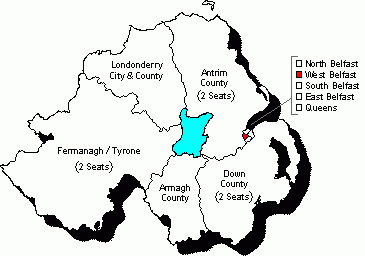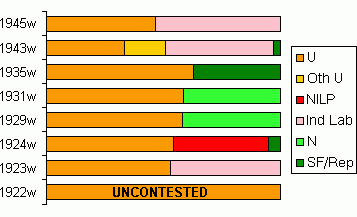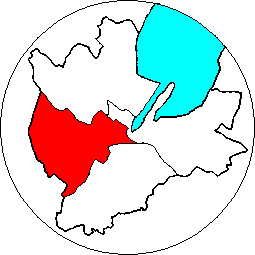

 |

|
| |
| |

|

|

|
| Map and diagram by Conal Kelly | ||
Incorporating the western quarter of the city of Belfast, this constituency was established under the terms of the Government of Ireland Act 1920. The original West Belfast constituency had been eliminated as a result of the 1917 Redistribution of Seats (Ireland) Act. This new constituency replaced the short-lived Westminster seats of Woodvale, Falls and St. Anne’s. Between 1922 and 1949 the constituency was represented by four different MPs (3 Unionist, 1 Independent Labour). The longest serving of these was Unionist Capt. Alexander Crawford Browne, who was first elected in 1931 and continued to represent the constituency until his death in 1943. Only the general election of 1922 went uncontested. The declared winner was the sole Unionist nominee. The constituency had the highest turn-out across Northern Ireland in the 1924 and 1929 general elections.
See also election results for West Belfast 1950-1970, 1973-1982, 1983-1992 and 1993-2007.
| U | Ind U | NILP | Ind Lab | Nat | SF/Rep | |
| 1945w | 46.5% | 53.3% | ||||
| 1943w-b | 33.4% | 17.5% | 46.2% | 2.9% | ||
| 1935w | 62.6% | 37.4% | ||||
| 1931w | 58.6% | 41.4% | ||||
| 1929w | 57.9% | 42.1% | ||||
| 1924w | 54.4% | 40.4% | 5.1% | |||
| 1923w | 52.9% | 47.1% | ||||
| 1922w | * |
* The only candidate nominated for the 1922 General Election was Unionist Robert Lynn. As the sole candidate he was therefore duly elected without a contest.
Independent Labour majority: 4,058; electorate: 78,674; votes cast: 73.1%
Determined to recapture
the seat lost to Beattie in the 1943 by-election, the Unionist Party once
again selected Samuel Knox Cunningham. This time there was no other unionist
candidate on the ballot to split the vote. In a substantially higher turn-out,
Cunningham managed to consolidate the unionist vote and increase it by almost
5,000 compared to the by-election. However, Beattie, now standing an an
Independent Labour candidate, was able to increase his tally by over 10,000
votes and comfortably retained his seat.
Beattie would go on to lose the seat in the 1950 Westminster
election, regain it in 1951 and lose it again in
1955. Cunningham would go on to win a seat in South Antrim
in the 1955 Westminster elections. He would hold that seat until
1970. Cunningham was appointed Parliamentary Private Secretary for Prime
Minister Harold Macmillan in 1959.
Independent Labour majority: 5,510; electorate: 78,763; votes cast: 54.8%
Browne, who had been
the MP for West Belfast since 1931, died in December 1942. In the resulting
by-election, there was a relatively packed field, with no less than four
candidates competing. The Unionist Party selected barrister Samuel Knox Cunningham to
defend the seat that they had held since 1922. The unionst vote was also being
courted by Independent Unionist, William Wilton. The Northern Ireland Labour
Party were contesting the seat for the first time since 1924, with their
veteran candidate Jack Beattie. Rounding out the field was Independent
Republican, Hugh Corvin. The result sent shockwaves through the Unionist
establishment. The splitting of the unionist vote between Cunningham and
Wilton allowed Beattie to top the poll, becoming the the first labour MP
elected for Northern Ireland.
Beattie had been a member of the NILP (and one time leader) until he was
expelled in 1934. He was readmitted to the party in 1942 before resigning
again the following year. He formed the Federation of Labour in 1945 before
disbanding it and joining the Irish Labour Party in 1949. Beattie had
represented East Belfast in the Northern Ireland House of Commons between
1925-1929 and Pottinger between 1929-1949.
Wilton had previously unsuccessfully contested the 1933 Northern Ireland
general elections Belfast Oldpark and the 1938 general elections in Belfast
Clifton. He would go on to serve as a member of the Northern Ireland Senate
from 1945 to 1953.
Corvin had previously contested the 1924 Westminster elections as a Sinn
Fein candidate in North Belfast.
Unionist majority: 13,747; electorate: 79,902; votes cast: 68.0%
Defending his seat in
1935, Browne would face a new opponent in the form of Republican candidate
Charlie Leddy. While Leddy managed to attract over 37% of the vote, the
result was still a comfortable victory for Browne, who increased his majority
by over 4,000 votes.
Leddy was editor of the Belfast republican publication An Siul. It
would subsequently be banned by the Northern Ireland government in 1936.
Unionist majority: 9,107; electorate: 77,993; votes cast: 68.1%
Following Allen's
defection to the New Party, the Unionists chose Capt. Alexander Crawford
Browne as their candidate. As was the case in 1929, opposition came in
the form of the Nationalist Party and their new candidate Tom Campbell.
On a slightly reduced turn-out, the Unionists managed to comfortably retain
the seat and Browne became the new MP for West Belfast.
Browne had been previously elected to Belfast City Council in 1924. Campbell
had previously stood unsuccessfully for the Irish Parliamentary Party (IPP) in
South Monaghan at the 1918 general election. He had been appointed to the
Northern Ireland Senate in 1929. He would later be elected to the Northern
Ireland House of Commons in a 1934 by-election for Belfast Central.
Unionist majority: 9,097; electorate: 77,721; votes cast: 73.9%
Following Lynn's retirement
from Westminster, the Unionist Party selected the London based William Allen to
defend the West Belfast seat. Allen would face opposition from the Nationalist
Party's candidate Frank MacDermot. Despite being the closest contest of the
election in Northern Ireland, Allen still managed a comfortable majority of over
9,000 votes. At 73.9%, West Belfast had the highest turn-out across Northern
Ireland in the 1929 election.
Allen had previously contested the two-seat Fermanagh
and Tyrone constituency for the Unionists in the 1922 Westminster elections.
In 1931 he would defect from the Unionist Party and join Sir Oswald Mosley's
facist New Party. He did not conest the 1931 election.
Frank MacDermot was subsequently elected to the Dáil at the 1932 Irish general
election as an Independent for Roscommon. He would later serve in the Seanad
between 1938 and 1943, as a nominee of the Taoiseach.
Unionist majority: 7,313; electorate: 66,010; votes cast: 79.1%
In the 1924 election,
Lynn once again faced opposition from Harry Midgely, now standing under
the Northern Ireland Labour Party (NILP) banner. This time round there
would also be a third candidate in the race, Patrick Nash, representing Sinn
Fein. Nash was one of eight Sinn Fein candidates put forward in 1924. The
addition of Nash to the field appears to have eaten into Midgely's tally
and Lynn was returned with an increased majority. At 79.1%, West Belfast
had the highest turn-out across Northern Ireland in the 1924 election. It
was also the closest result of the election.
Midgely would go on to be elected in the 1933 Northern Ireland general
election for Belfast Dock and again in a 1941 by-election for Belfast
Willowfield. He founded the Commonwealth Labour Party (CWLP) in 1942 and
would serve as Minister of Public Security and Minister of Labour. Midgely
would stand as a CWLP candidate in South Belfast
in the 1945 Westminster election. He eventually disbanded the CWLP and
joined the Unionist Party in 1947.
Unionist majority: 2,750; electorate: 67,161; votes cast: 70.3%
Unlike the 1922 election,
Lynn faced opposition in defense of his seat in 1923. West Belfast was one of
only three constituencies contested across Northern Ireland. His opponent was
Independent Labour candidate Harry Midgely. In what was a relatively closes
contest, Lynn edged past Midgely with a majority of 2,750.
Midgley had been elected to Belfast City Council in 1920 as a Belfast Labour
candidate.
Unopposed Unionist Candidate.
This was the first election
for the newly established West Belfast constituency. The new constituency replaced
the Belfast Woodvale, Belfast Falls, and Belfast St. Anne’s constituencies that had
been used in the 1918 election. Robert Lynn had been previously elected to represent
Woodvale in 1918 and as the sole nominee he was duly elected without a contest for
West Belfast.
Lynn had also been elected to the Northern Ireland House of Commons in 1921 as a member
for West Belfast (4 seats). He would later switch seats to North Antrim in 1929. He
would go on to serve as Deputy Speaker of the Northern Ireland House of Commons between
1937 and 1944.
See also:
Results from 1922 to 1949 for each seat: East Belfast | North Belfast | South Belfast | West Belfast | Antrim | Armagh | Down | Fermanagh and Tyrone | Londonderry | Queens University
Other sites based at ARK: ORB (Online Research Bank) | CAIN (Conflict Archive on the INternet) | Northern Ireland Life and Times Survey
Your comments, please! Send an email to me at nicholas.whyte@gmail.com.
Conal Kelly, 10 October 2007.
|
Disclaimer:©
Nicholas Whyte 1998-2004 Last Updated on Wednesday, 12-Jan-2005 12:12
|